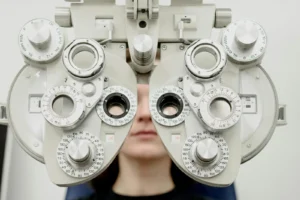Diabetes
Diabetes is a chronic medical condition characterised by elevated blood sugar levels, which result from either insufficient insulin production or the body’s ineffective use of insulin. This condition affects millions of people worldwide and can have significant impacts on various aspects of health. There are two primary types of diabetes:
Type I Diabetes
In individuals with Type I diabetes, the pancreas, an essential gland located behind the stomach, fails to produce an adequate amount of insulin. Insulin is a hormone that plays a critical role in regulating blood glucose levels by facilitating the uptake of glucose into cells for energy production. Without sufficient insulin, glucose remains in the bloodstream, leading to high blood sugar levels. This type of diabetes typically manifests in childhood or adolescence but can occur at any age. People with Type I diabetes require lifelong insulin therapy to manage their blood sugar levels and prevent complications. The condition demands regular monitoring of blood glucose, along with careful management of diet and physical activity.
Type II Diabetes
Type II diabetes is the more common form of diabetes and occurs when the body’s cells become resistant to the action of insulin. Despite the pancreas producing insulin, the body’s cells do not respond effectively, resulting in elevated blood sugar levels. Over time, the pancreas may also produce less insulin in individuals with Type II diabetes. This type of diabetes is often associated with lifestyle factors, such as being overweight or inactive, but can also be influenced by genetic predisposition. Managing Type II diabetes generally involves lifestyle changes, including a balanced diet, regular exercise, and sometimes medications that improve insulin sensitivity or reduce glucose production by the liver. Early detection and intervention are crucial to manage this condition effectively and mitigate the risk of complications.
Diabetic Retinopathy
One of the serious complications of diabetes is diabetic retinopathy, a condition that affects the eyes. Prolonged high blood sugar levels can cause damage to the retina, the light-sensitive layer at the back of the eye that is crucial for vision. This condition represents a significant risk to vision and underscores the importance of good diabetes management. Diabetic retinopathy progresses through four main stages, each with distinct signs and potential impacts on vision:
Background Retinopathy
This early stage is characterised by the weakening of blood vessels on the retina, leading to tiny amounts of blood leakage. At this point, vision is usually not affected, and the condition might be detected only through a comprehensive eye examination. Small microaneurysms may form on the retina, and while these changes may not impact vision immediately, they signal the need for vigilant eye care and diabetes management.
Pre-Proliferative Retinopathy
As the condition progresses to this stage, the bleeding from the retinal blood vessels becomes more severe, and the oxygen supply to the eye is reduced. Fluid leakage may occur, which can start to affect vision and may require closer monitoring. The retinal blood vessels may become blocked or damaged, leading to retinal ischemia. This loss of blood supply can cause significant damage if not managed promptly.
Proliferative Retinopathy
At this more advanced stage, new, fragile blood vessels grow due to the reduced oxygen supply to the retina. Meanwhile, the older blood vessels may form scars. These two changes can lead to significant vision loss, and there is a risk of permanent vision loss if left untreated. These new vessels are prone to leaking and rupturing, leading to vitreous haemorrhages that further compromise vision. Prompt treatment is essential to prevent severe complications.
Advanced Diabetic Retinopathy
In this critical stage, bleeding may extend into the vitreous, the gel-like substance filling the eye. Scarring from this bleeding can cause the retina to pull away from the back of the eye, resulting in a retinal detachment, which can lead to severe and potentially permanent vision loss. Additionally, excess fluid or bleeding around the macula, the central part of the retina responsible for sharp vision, can cause rapid vision deterioration. At this stage, urgent medical intervention is necessary to salvage vision and prevent further decline.
How to Reduce Your Risk of Diabetic Retinopathy
Managing diabetes effectively and taking proactive steps can significantly reduce the risk of developing diabetic retinopathy. Here are key measures to help protect your eye health:
- Take Regular Exercise: Engaging in consistent physical activity helps control blood sugar levels, improve overall health, and reduce the risk of diabetes-related complications. Exercise enhances insulin sensitivity and aids in maintaining healthy body weight, which is crucial for managing diabetes.
- Stop Smoking: Smoking can exacerbate the harmful effects of diabetes on blood vessels, including those in the retina. Quitting smoking is crucial for reducing these risks. Smoking cessation not only improves general health but also enhances blood flow to the retina, reducing the risk of retinopathy.
- Eat Healthily: A balanced diet that regulates blood sugar levels is vital for managing diabetes and maintaining overall health. Consuming a diet rich in fruits, vegetables, whole grains, lean proteins, and healthy fats can stabilise blood sugar levels and support overall well-being.
- Check and Monitor Blood Sugar and Cholesterol Levels: Regular monitoring and maintaining healthy levels are essential for managing diabetes and reducing the risk of complications. Keeping blood pressure and lipid levels within target ranges also helps safeguard eye health.
- Have Regular Eye Tests: Yearly eye examinations are crucial for early detection and management of diabetic retinopathy. Regular exams allow for timely intervention, potentially preventing progression to more advanced stages.
- Consult Your GP: If you notice any symptoms of diabetes or changes in your vision, consulting your general practitioner is essential for timely intervention. Regular check-ups with your healthcare provider ensure that your diabetes management plan is effective and tailored to your needs.
Diabetic Retinopathy Treatment
Treatment for diabetic retinopathy depends on the stage of the condition. During the initial stages (background and pre-proliferative retinopathy), treatment may not be immediately necessary, but close monitoring is crucial. If the condition progresses to more advanced stages, medical interventions may include:
- Laser Surgery: Laser treatment can be used to shrink abnormal blood vessels and reduce the risk of vision loss. This procedure, called photocoagulation, seals or destroys leaking blood vessels, preventing further damage to the retina.
- Vitrectomy: Surgery on the vitreous (the gel within the eye) may be necessary to remove the blood and scar tissue that can cause retinal detachment. This procedure helps to clear the vitreous and repair any retinal detachments, restoring vision as much as possible.
Regular Eye Tests
Diabetics are strongly advised to have an eye test at least once a year. In the UK, those with diabetes are entitled to free annual eye tests on the NHS. Regular eye examinations are vital for detecting early signs of diabetic retinopathy and preventing severe vision complications through timely treatment. Through these tests, other eye conditions, such as glaucoma and cataracts, which are also more common in diabetics, can be identified and managed appropriately. By adhering to a regular eye examination schedule, individuals can maintain optimal eye health and overall well-being.
In conclusion, managing diabetes effectively and undergoing regular eye tests are crucial steps in preventing diabetic retinopathy and ensuring long-term visual health. Education about diabetes and its potential complications can empower individuals to take control of their health and reduce the risk of serious eye conditions. Taking proactive measures today can safeguard your vision and maintain a high quality of life for the future.



